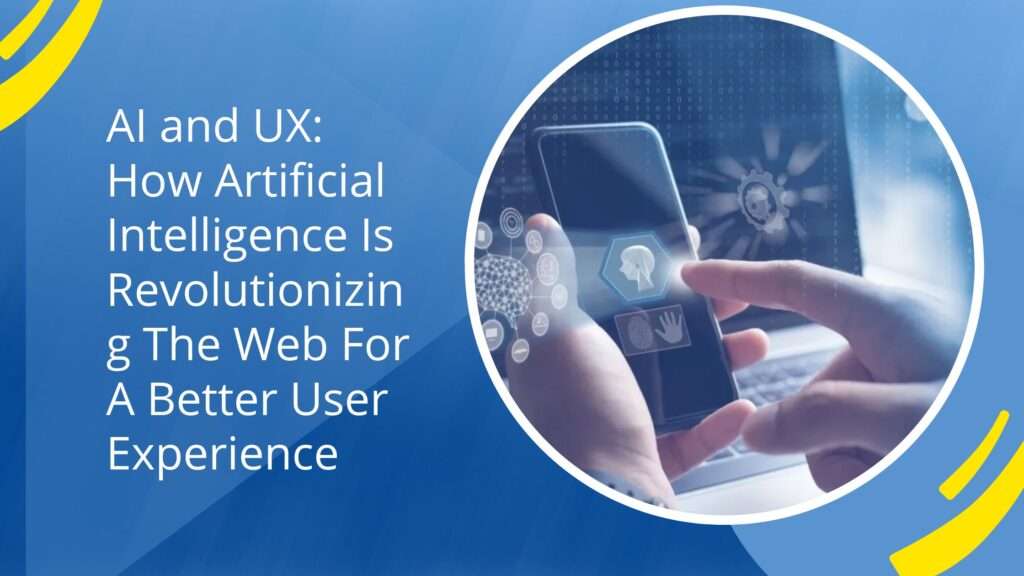In a world where technology is constantly advancing, it’s no surprise that Artificial Intelligence (AI) is having a major impact on the way companies design user experiences on their websites. Learn more in this article about how AI is revolutionizing UX and what this could mean for businesses looking to capitalize on the potential of AI-driven web experiences in the future.
Introduction to Artificial Intelligence (AI)
In the past few years, we have seen a dramatic increase in the use of artificial intelligence (AI) in various industries. AI is providing new opportunities for businesses to interact with their customers and employees in more natural and efficient ways. In this blog post, we will take a look at how AI is revolutionizing the web for a better user experience.
One of the most impactful ways AI is changing the web is through chatbots. Chatbots are computer programs that can mimic human conversation. They are commonly used to provide customer support or perform other simple tasks such as taking orders or answering questions.
What makes chatbots so powerful is their ability to understand human language. This allows them to have conversations with users in a way that feels natural and human-like. Additionally, chatbots can learn over time and become more efficient at completing tasks.
Another way AI is changing the web is through its ability to personalize content. With the help of machine learning, AI can analyze user data to better understand their needs and preferences. This allows businesses to tailor their website content and ads to each individual user, resulting in a more personalized experience.
Finally, AI can also be used to improve security on the web. By using tools like facial recognition and biometrics, businesses can verify the identity of users and prevent fraudsters from accessing sensitive information. Additionally, AI can help businesses detect malicious activity on their websites and take measures to protect against it.
What is User Experience (UX)?
User experience (UX) is the process of creating a system that provides a great user experience. It involves the design of the overall system, including the hardware, software, and interfaces. UX designers work to create a system that is easy to use and provides a great user experience.
Artificial intelligence (AI) is revolutionizing the web for a better user experience. AI can help improve the usability of websites and make them more efficient. For example, AI can help you search for information on a website more easily. Additionally, AI can help you find new ways to interact with websites and services.

How AI is Improving UX on the Web
Artificial intelligence (AI) is revolutionizing the web for a better user experience. By automating repetitive tasks, AI can help web designers focus on more creative work. Additionally, AI can help create more personalized user experiences by understanding a user’s preferences and providing relevant content and recommendations. Finally, AI can improve website performance by optimizing site content and layout based on user behavior.
AI Tools for Enhancing UX
Artificial intelligence (AI) is becoming increasingly prevalent in our everyday lives, with its application ranging from personal assistants to self-driving cars. While many people think of AI as advanced gaming characters or Hollywood A.I. like the voice of Siri in the iPhone, AI is also quietly and rapidly revolutionizing web design and user experience (UX).
There are a number of AI tools that are being developed specifically for enhancing UX, such as:
1. Algorithmic design tools: These tools use algorithms to generate design solutions based on inputted constraints and preferences. They can be used to create everything from website layouts to logo designs.
2. Brain computer interfaces: These interfaces allow users to interact with computers using brainwaves instead of traditional input methods like keyboards or touchscreens. This technology is still in its early stages, but has great potential for UX applications such as hands-free navigation and control.
3. Predictive analytics: Predictive analytics uses data mining, machine learning, and artificial intelligence to analyze current trends and predict future outcomes. This information can be used to improve website design, content, and user flows.
4. Chatbots: Chatbots are computer programs that simulate human conversation. They can be used to provide customer support or guide users through complex processes on websites or apps.
5. Virtual reality:Virtual reality (VR) allows users to immerse themselves in digital environments that look and feel realistic. VR is a powerful tool for UX research, as it can help designers gain valuable insight into how users interact with their products.
6. Natural language processing (NLP): NLP is a branch of artificial intelligence that enables computers to interpret and understand human language. This technology is key to creating more intuitive user interfaces and can be used to make conversations with chatbots more natural.
Examples of AI Used for UX Improvement
There are already many examples of artificial intelligence being used to improve the user experience on websites and apps. Here are a few of the most notable:
1. Personalized recommendations. AI is being used more and more to personalize the recommendations we see on our favorite websites. This is possible because AI can analyze our past behavior and preferences to make better predictions about what we might want to see in the future.
2. Automated customer support. Chatbots are one of the most visible examples of AI being used to improve customer support on websites. These virtual assistants can handle simple tasks like answering FAQs and providing basic information about a company’s products or services.
3. Improved search results. Search engines like Google are using AI to provide more relevant and accurate search results for users. This is possible because AI can understand the intent behind a user’s query and match it with the most relevant content available.
4. Smarter forms and surveys. Websites are using AI to create forms and surveys that are smarter and more efficient. This is possible because AI can help identify errors in data entry, ensure that required fields are filled out, and flag duplicate responses.
5.Enhanced security measures . Many website owners are now turning to AI to help them beef up their security measures. This is possible because AI can be used to monitor user activity for suspicious behavior, block malicious traffic, and even thwart attacks before they happen .
Benefits of Using AI for UX Improvement
There are many benefits of using AI for UX improvement. One of the most obvious benefits is that it can help you design better user interfaces. By understanding how users interact with your site or app, AI can help you optimize your design for a better user experience.
Another benefit of using AI for UX improvement is that it can help you personalize the user experience. By understanding the user’s preferences and behaviors, AI can help you customize the content and features that they see to improve their overall experience.
AI can also help you automate tasks related to UX improvement. For example, if you’re constantly making small changes to your design based on user feedback, AI can help you automate this process so that you can focus on other aspects of your business.
In general, using AI for UX improvement can help you save time and resources while still providing a great user experience for your users.
Challenges Facing AI and UX Integration
One of the key challenges facing AI and UX integration is that of data privacy. As more and more companies collect data on users, there is a greater risk of this data being mishandled or simply stolen in a data breach. This has led to increased calls for regulation around data privacy, which could hamper the use of AI in user experience design.
Another challenge is the potential for AI to automate away many jobs that are currently performed by human beings. This could lead to large-scale unemployment and social upheaval, as well as increasing inequality between those who have the skills to work with AI and those who do not.
Finally, there is also the risk that AI will be used to manipulate and control people rather than help them. This could happen through the use of personalized ads and other forms of targeted marketing, or through the subtle manipulation of algorithms to biased results. If not carefully monitored, AI could be misused in ways that have harmful consequences for individuals and society as a whole.
Conclusion
Artificial intelligence is revolutionizing the web and creating a better user experience. AI-powered solutions are quickly becoming ubiquitous, from virtual assistants to content management systems. By leveraging the power of machine learning and natural language processing, developers can create more intuitive experiences that provide a seamless transition between platforms while ensuring that user data remains secure. With AI transforming the way we interact with websites and apps, now’s the time to start exploring what this technology has to offer your business!

